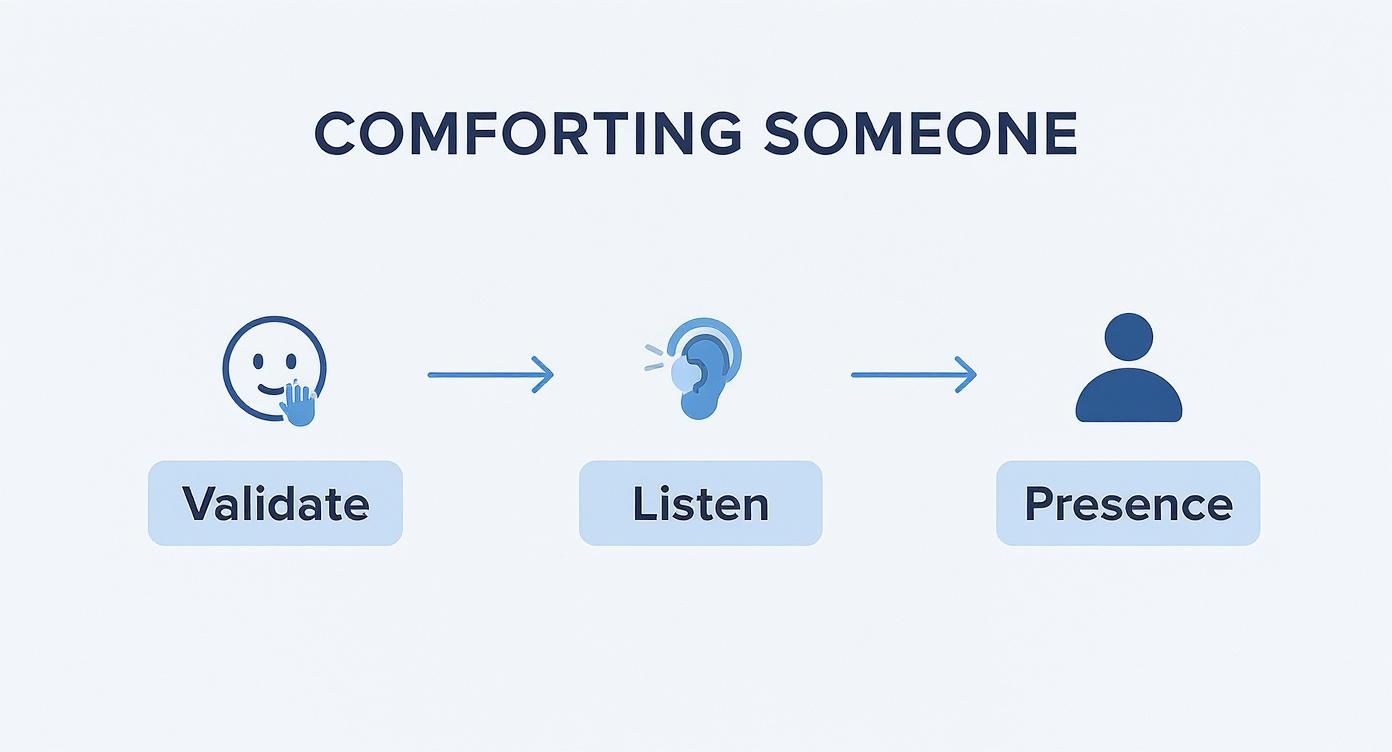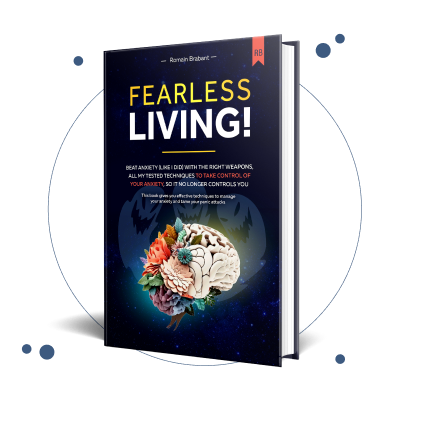
To really comfort someone with anxiety, you have to make a crucial shift: stop trying to fix their feelings and start trying to understand them. Your job isn't to solve their worries. It's to be a safe, validating presence that shows them they're not going through it alone. This kind of empathy is the bedrock of offering real comfort and instilling hope for a panic-free future.
Understanding Anxiety From Their Perspective
Before you can offer genuine comfort, you need to get a feel for what anxiety is like from the inside. Forget the clinical definitions for a second. Instead, picture being in a constant state of high alert, where your mind just won't stop racing with "what if" scenarios you can't control. This isn't just everyday worry; it's a full-body experience that can be overcome.
Think of it as their body's alarm system getting stuck in the "on" position. Their nervous system is braced for a threat that isn't even there. This can show up as a knot in their stomach, a racing heart, shallow breathing, or a sudden, crushing sense of dread that seems to appear out of thin air. You can learn more about this biological reaction in our detailed guide on the fight-or-flight response.
Why "Just Relax" Doesn't Work
This is exactly why well-meaning advice like "just relax" or "don't worry about it" can feel so dismissive. For the person in the thick of it, their struggle isn't a switch they can just flip off. Phrases like that can accidentally imply they're failing at something basic, which only piles a layer of shame on top of their anxiety.
Instead of trying to offer solutions, the most powerful thing you can do is offer validation. When you acknowledge their reality without judgment, you create a safe space where healing can begin. That simple act of acceptance is the first step toward true recovery.
Your goal isn't to pull them out of the storm, but to sit with them in it, holding an umbrella. This presence communicates safety, acceptance, and the hopeful message that storms always pass.
This kind of support is incredibly important, especially when you look at the numbers. Anxiety disorders are the most common mental health conditions in the world, affecting nearly 1 in 5 adults in the United States in the last year. Globally, only about one in four people with these conditions get any kind of treatment, which just goes to show how vital your support is in their healing journey.
Shifting Your Mindset for Hope
By changing your approach from fixing to supporting, you open the door for them to believe a panic-free life is truly attainable. You become a steady anchor in their chaotic inner world, reinforcing that their feelings are real but not permanent. For a more holistic look at where anxiety can come from, it can be helpful to explore the intricate connection between the gut and brain. Your empathetic presence doesn't just comfort them in the moment; it builds their resilience and gives them the hope they need to take the first steps toward lasting healing.
What to Say and Do During a Panic Attack
When you see someone spiraling into a panic attack, your words and presence can be a powerful anchor. The experience is incredibly isolating, and your calm, steady support can make all the difference. It reminds them they aren't alone and that this intense moment will pass.
Your primary role isn't to stop the panic attack—that's often beyond anyone's control. It’s to provide a safe harbor until it passes. Non-verbal cues are huge here. Stay calm, speak in a gentle tone, and avoid any sudden movements. Your collected presence communicates safety and reinforces the idea that recovery is possible.
Grounding Them in the Present Moment
During a panic attack, a person’s world shrinks. Their focus turns inward, completely consumed by overwhelming fear and intense physical sensations. The best way to help is to gently guide their attention back to the present environment. This technique, called grounding, works by shifting their focus away from the internal chaos and toward the safety of the here and now.
A go-to method is the 5-4-3-2-1 technique. It’s simple and effective.
- Ask them to name five things they can see around them.
- Then, ask them to identify four things they can physically feel (like the texture of their jeans or their feet on the floor).
- Next, have them listen for three distinct sounds.
- Ask them to name two things they can smell.
- Finally, have them name one thing they can taste.
This simple exercise pulls their mind out of that terrifying spiral by re-engaging their senses. It’s a practical action that reinforces the idea that they can regain a sense of control and that healing is a series of manageable steps.
This infographic breaks down a simple, effective flow for offering comfort: validate their feelings, listen without judgment, and just be there.

It highlights that your support is about connection, not correction. That’s a game-changer for someone feeling overwhelmed and a key part of their path to recovery.
Using Calming Words and Actions
The right words can validate their experience without being patronizing. Saying "You're fine" can feel incredibly dismissive. Instead, try phrases that offer solidarity, hope, and gentle guidance.
When someone is in the thick of it, knowing what to do—and what not to do—can be tricky. Here’s a quick reference to help you navigate those intense moments.
Immediate Support Do's and Don'ts
| Helpful Actions (Do) | Unhelpful Actions (Don't) |
|---|---|
| Say, "I'm right here with you. You're not alone." | Say, "Just calm down" or "Stop worrying." |
| Ask, "What do you need from me right now?" | Make assumptions about what they need. |
| Remind them, "This feeling is temporary and it will pass." | Minimize their fear by saying, "It's not a big deal." |
| Gently guide their breathing. | Express frustration or impatience with them. |
This table isn't about memorizing scripts; it’s about shifting your mindset from fixing the problem to providing a supportive presence that fosters hope.
Guiding their breath can be particularly powerful. You might say something like, "Let's try to breathe together. I'll count. In for four… hold… and out for six." For more structured techniques, you can explore various breathing exercises for anxiety that offer clear, actionable steps for regaining calm and building long-term resilience.
Remember, your presence is your most powerful tool. By staying with them through the peak of their fear, you are silently communicating a message of unwavering support and hope: "You can get through this, and I will be here until you do."
Providing Consistent Long-Term Support

Real support doesn't just show up during a crisis. It's about being a steady, reliable presence that helps them build the foundation for lasting healing. This consistency creates the safety and trust they need to believe that a life without constant panic isn't just a fantasy—it's completely achievable.
Your role here shifts from a problem-solver to a compassionate partner in their recovery. You don't need to have all the answers. The goal is to create a space where they feel seen, heard, and empowered to reclaim their life from anxiety.
Celebrating Small Wins and Recognizing Triggers
Recovery isn’t a single giant leap; it's a journey made of tiny, brave steps. One of the most powerful things you can do is cheer for those small victories, as they are the building blocks of a panic-free life.
Did they make that phone call they’d been dreading? Did they manage to stay at a party for twenty minutes instead of five? These are huge wins. Acknowledge them.
Saying something like, “I know how hard that was for you, and I’m so proud you did it,” validates their incredible effort. This kind of positive reinforcement helps build momentum, shifting their focus from what anxiety takes to what they are capable of reclaiming. If you're looking for a more structured way to support this process, our guide on anxiety recovery steps is a great resource.
You can also gently help them connect the dots with their triggers. Without being pushy, you might notice patterns they miss—like how their anxiety seems to ramp up after a rough night of sleep or before a big meeting at work.
You could simply say, “I’ve noticed things seem tougher after a late night. Is there anything we can do to protect your sleep schedule a bit more?” This turns you into a collaborative partner in their journey toward wellness.
The Power of Listening and Self-Care
Sometimes, the most profound comfort you can offer is your quiet, focused attention. This means truly listening—not just waiting for your turn to speak or jumping in with solutions.
Let them talk. Let them get it all out without interruption. Then, reflect back what you heard: “It sounds like you’re feeling completely overwhelmed by all of this.” This simple act makes them feel validated and less alone on their path to healing.
True companionship isn't about solving their problems. It’s about creating a space where their fears can be spoken aloud without judgment, which strips them of their power and paves the way for hope.
Remember, this is a marathon, not a sprint. Your own well-being is non-negotiable. Setting boundaries isn’t selfish; it’s what makes your support sustainable. You can't pour from an empty cup.
Take time for yourself. Be honest if you don’t have the emotional bandwidth at a certain moment. This self-care ensures you can continue to be the steady, compassionate ally they need for the long haul. A calming environment can also make a world of difference, so consider learning about creating a home that feels like a warm hug to build a physical sanctuary of peace.
Encouraging Professional Help Without Pressure

Your support is an incredible gift, but it’s one part of the solution. At some point, bringing up therapy or counseling can be a pivotal step toward real, lasting healing. This conversation, handled with care, can be one of the most hopeful you'll ever have.
The goal isn't to pressure them. It’s to open a door, gently, from a place of genuine concern. You're framing it as a proactive step toward getting their life back—a powerful move toward a future free from panic.
Think of it this way: you’re suggesting they add a trained expert to their support team. You can start the conversation by focusing on what you've seen and how much you care.
Try saying something like, "I've noticed how much you've been struggling lately, and it hurts me to see you in so much pain. I was thinking that talking to someone who specializes in this could give you the tools to heal and live the life you deserve."
This shift in language positions therapy as a strategy for getting stronger, not a sign of being "broken."
Making the First Step Less Intimidating
For someone drowning in anxiety, finding a therapist can feel overwhelming. This is where your practical support can be a game-changer, showing them that the path to healing is manageable. Offering to help with logistics removes huge barriers and proves you’re in their corner.
You can make the whole process feel less daunting.
- Offer to help with research: "If you want, we could look for some therapists online together. No pressure, just to see who’s out there."
- Assist with the hard parts: The first phone call is often the most terrifying. Offer to help them draft an email or sit with them while they make the call.
- Provide physical support: "I can drive you to your first appointment and hang out in the waiting room. You won't have to do it alone."
The key is to frame these offers as a partnership. You're not taking over; you're clearing the path so they feel safe enough to walk it and begin their healing journey.
Destigmatizing the Process
Globally, anxiety is a massive burden, but stigma and a lack of awareness stop many from getting help. While about half of U.S. adults with a mental illness get treatment, that number drops to a staggering 27.6% for people with anxiety worldwide.
That means most people are relying on informal support from people just like you. Your gentle encouragement is vital. As a report on mental health services from the World
Health Organization points out, community-level support is crucial for recovery.
Your role is to reinforce that asking for help is a sign of incredible strength and the first step toward a hopeful future. It's an act of courage.
For anyone curious about what treatment involves, learning about the different types of psychotherapy for anxiety can help demystify the entire process. By normalizing therapy, you help them see it for what it truly is: a proven and effective path toward reclaiming their life.
Building a Hopeful Path Forward Together
Supporting someone with anxiety is a journey, not a quick fix. But it's a journey filled with incredible potential for growth, resilience, and profound healing. The real goal isn't just to manage anxiety, but to build a life where it no longer sits in the driver's seat. A full, meaningful life, free from panic, is absolutely possible.
This path forward is paved with your genuine support. It starts with listening—not to solve, but to understand. From there, it's about offering a calm, steady presence that acts as an anchor during stormy moments, reminding them that the sun will come out again.
Your unwavering support is a powerful catalyst. It helps them shift from feeling controlled by anxiety to feeling confident in their ability to heal. This shared resilience turns what feels like a lonely battle into a collaborative journey toward a brighter future.
Fostering Hope and Empowerment
One of the most powerful things you can offer is hope. Anxiety is a notorious liar, whispering that the fear is permanent and a peaceful mind is impossible. Your consistent belief in their capacity to heal is a direct counter-narrative to that voice.
Remind them of their own strength. Make a point to celebrate every small victory, whether it’s getting through a difficult meeting or simply navigating a challenging day. These moments are the real building blocks of a confident, panic-free life.
Your role is not to be their savior, but their champion. When you believe in their ability to get better, you help them start believing in it, too. This shared optimism is the foundation upon which a healed future is built.
Encouraging simple practices that cultivate a more positive mindset can also make a huge difference. For example, our guide on using a gratitude journal for anxiety explores a simple yet effective tool for shifting focus toward what feels good and stable in their life.
The Ultimate Takeaway: A Shared Future
Every single act of compassion sends a clear message: "You are not alone, and a peaceful, panic-free life is within your reach." It could be as simple as validating their feelings or as involved as helping them research therapists.
Anxiety thrives in isolation, but it shrinks in the presence of real connection and hope.
While the journey has its challenges, it is absolutely possible for someone to heal from their anxiety and reclaim their life. Your support doesn't just comfort them in the present; it empowers them to build a future where they are not just surviving, but truly thriving.
Got Questions About Supporting Someone With Anxiety?
Trying to figure out how to comfort someone with anxiety can feel like walking on eggshells. It's normal to have questions or worry you'll say the wrong thing. Let's tackle some of the most common challenges so you can offer support with confidence and hope.
What if They Push Me Away When I Try to Help?
When someone with anxiety pushes you away, it’s almost never about you. It's often a sign they’re feeling overwhelmed, embarrassed, or ashamed. They might feel like a burden and are trying to protect you, or they just don’t have the energy to engage.
The best thing you can do is respect their need for space while gently reminding them you're still there. Try saying something like, "I get it, you need a minute. Just know I'm here for you when you're ready, and I'm not going anywhere."
This act validates their feelings without making them feel abandoned. Your steady, low-pressure presence reinforces that they are worthy of support even on their hardest days, which is a crucial part of the healing process.
Can I Do Anything to Prevent Their Anxiety Attacks?
While you can't prevent their anxiety attacks, you can absolutely help create a supportive environment that fosters resilience and healing. Your role isn't to be a shield against every stressor but to be a partner in building their long-term well-being.
Help them start noticing patterns or triggers—maybe it's a lack of sleep or too much caffeine—and then brainstorm ways to manage them together.
Encouraging healthy habits like a regular sleep schedule, eating well, and moving their body can make a huge difference. This empowers them with the tools to build a more resilient mind and body, showing them that a life with less anxiety is something they can actively create.
Helping empowers them to face their fears; enabling helps them avoid them. For example, helping sounds like, 'I know that social event feels impossible, but what if we go together for just 30 minutes?' Enabling sounds like, 'Don't worry, I'll make an excuse for you so you don't have to go.'
How Do I Know if It’s Serious Enough for a Doctor?
The biggest clue is how much the anxiety is impacting their daily life. Is it stopping them from going to work, school, or doing things they used to love? When their world starts to shrink because of fear, that's a clear sign that professional support is a hopeful next step.
Physical symptoms are another major red flag. If they’re always exhausted or dealing with ongoing headaches or stomach problems, their body is signaling that the stress is taking a serious toll.
You could gently bring it up by saying, "I'm worried about how much this is affecting you. It seems so heavy to carry alone. Maybe talking to someone could help you find a way to heal and feel like yourself again." This isn't about diagnosing them; it's about lovingly pointing toward a path of recovery and strength.
At The Anxiety Checklist, we believe everyone deserves to live a life free from the grip of panic and chronic worry. Our Fearless Living system provides a practical, step-by-step toolkit to help you or your loved one understand anxiety, challenge negative thought patterns, and build lasting resilience. Discover the tools you need to build a more fearless life today.

